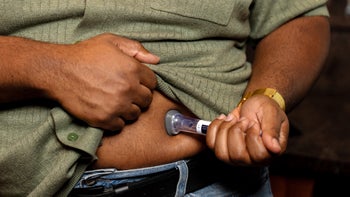
Tirzepatide’s Mechanism of Action: 6 Ways Tirzepatide Works for Weight Loss and Diabetes
Key takeaways:
Tirzepatide is a once-weekly injectable medication that’s available under two brand names: Mounjaro (for Type 2 diabetes) and Zepbound (for weight loss). Tirzepatide’s primary mechanism of action, or how it works, is mimicking two gut hormones.
Once injected, tirzepatide stimulates your pancreas to release insulin when you eat and lowers the amount of glucose (sugar) your liver makes. These actions help lower blood glucose for people with Type 2 diabetes.
Tirzepatide also slows the passage of food through the digestive tract and acts on areas of the brain that regulate appetite. It may also reduce food cravings. Together, these actions can contribute to weight loss.

Tirzepatide is a once-weekly injectable medication that’s available under two brand names: Mounjaro and Zepbound. Mounjaro is FDA approved to treat Type 2 diabetes in adults. Zepbound is approved for chronic weight management in certain adults.
Tirzepatide belongs to a medication class with a long name: dual glucose-dependent insulinotropic polypeptide (GIP) and glucagon-like peptide-1 (GLP-1) receptor agonist. It acts like GIP and GLP-1, two gut hormones that help regulate blood glucose (sugar), digestion, and appetite.
But what exactly happens in your body after you inject Mounjaro or Zepbound? Below, we break down tirzepatide’s mechanism of action and six ways it works to treat diabetes and promote weight loss.
Save every month on GLP-1 meds with GoodRx
Save an average of $235 on FDA-approved GLP-1s like Ozempic and Zepbound.

1. Tirzepatide tells your pancreas to release insulin after you eat
One of the ways tirzepatide helps lower blood glucose is by encouraging your pancreas to release more insulin after you eat. Insulin helps move glucose from your bloodstream into your cells. By making more insulin available, tirzepatide helps lower blood glucose levels, especially postmeal glucose levels.
Since tirzepatide only affects insulin after you eat, it carries a lower risk of hypoglycemia (low blood glucose) than some diabetes medications, such as sulfonylureas. Sulfonylureas, like glipizide, stimulate insulin release regardless of whether you ate.
2. Tirzepatide lowers the amount of new glucose your liver makes
Tirzepatide also lowers the amount of glucagon, a hormone released by the pancreas that tells the liver to make glucose. As a result, the liver produces less glucose. And this helps lower blood glucose levels for people living with Type 2 diabetes.
3. Tirzepatide slows the movement of food out of your stomach
It’s common to feel fuller than usual after meals while taking tirzepatide because it slows gastric emptying — how fast food moves from your stomach to your intestines. This action is beneficial for both Type 2 diabetes and weight loss. But it also contributes to many of tirzepatide’s digestion-related side effects, such as nausea and burping.
Slowed or delayed gastric emptying can lower your body’s absorption of carbohydrates from food. This can help balance glucose levels after you eat. And it can make you feel fuller for longer, causing you to eat less and lose weight over time.
For some people, tirzepatide’s impact on gastric emptying may only be temporary. Generally, this effect is most noticeable shortly after starting treatment. But people taking the highest Mounjaro dosage or Zepbound dosage (15 mg per week) may continue to experience the sensation of feeling fuller.
Compare tirzepatide injections: See what experts say about the similarities and differences between Mounjaro and Zepbound, two brand-name versions of tirzepatide.
What taking Mounjaro feels like: Real people share their experiences with Mounjaro, a medication that’s proven effective at treating Type 2 diabetes.
Possible side effects: Read about tirzepatide’s potential side effects — from diarrhea to hair loss — and how to manage them.
4. Tirzepatide targets areas in your brain that regulate appetite
In addition to its effects in the digestive tract, tirzepatide also affects the brain. There are receptors (chemical binding sites) for GIP and GLP-1 in areas of the brain that regulate your appetite. Once injected, tirzepatide attaches to these receptors, which can help lower your appetite. This can cause you to eat less and lose weight over time.
Good to know: While a smaller appetite is normal with tirzepatide, having no appetite isn’t. You should still be eating regular meals, preferably following a dietary plan decided on by you and your prescriber. If you find you have no appetite at all, let your prescriber know.
5. Tirzepatide may reduce cravings for certain foods
Tirzepatide’s activity in the brain may also reduce food cravings. So don’t be surprised if you no longer want to eat certain foods or snacks. Some people also report they have a lower desire to consume alcohol.
When you take a medication that mimics GLP-1, such as tirzepatide, it interferes with dopamine in the brain. Dopamine is a chemical that acts as a reward. When you eat food you enjoy, your brain releases dopamine and makes you want to eat it again. This can result in food cravings.
Tirzepatide interrupts this process, which can reduce cravings and potentially lessen “food noise” (constant thoughts about eating). These effects help people avoid eating when they’re not hungry. And this can contribute to weight loss.
Read more like this
Explore these related articles, suggested for readers like you.
6. Tirzepatide may counteract certain hunger hormones that affect weight gain
Tirzepatide may counteract certain hormones that contribute to weight gain.
Ghrelin and leptin are two hormones that help tell you when you’re hungry or full. But they work in somewhat opposite ways, as detailed in the table below.
Ghrelin (the “hunger” hormone) | Leptin (the “I’m full” hormone) | |
|---|---|---|
How it works | • Tells your brain it’s time to eat and your body to store fat • Produced mainly by the stomach • Signals your pancreas to release glucagon • May lower the amount of insulin released by the pancreas • Speeds up gastric emptying | • Tells your brain to eat less over the long term as your body creates more fat cells • Released from fat cells • Slows gastric emptying |
When you eat fewer calories, ghrelin levels rise and leptin levels fall. These changes make you feel hungrier and can cause you to eat more. This is one reason it can be difficult to maintain weight loss long term.
But tirzepatide may fight against these shifting hormone levels. Experts think this may be one reason why tirzepatide can help people maintain weight loss. But keep in mind that this effect only lasts for as long as you’re taking the medication. If you stop treatment, you may regain some of the weight you lost.
The bottom line
Tirzepatide (Mounjaro, Zepbound) is an once-weekly injection used for Type 2 diabetes and chronic weight management in adults. Tirzepatide’s main mechanism of action (how it works) is mimicking two gut hormones that regulate blood glucose (sugar), digestion, and appetite.
Tirzepatide helps treat Type 2 diabetes by telling the pancreas to release more insulin and the liver to make less glucose. Tirzepatide helps with weight loss by targeting areas of the brain that regulate appetite and food cravings, as well as counteracting certain hunger hormone changes. It also slows the movement of food through the digestive tract, which can be beneficial for both diabetes and weight loss.
Tirzepatide’s effects only last for as long as you take the medication. Long-term use may be necessary for continued diabetes or weight loss benefits.
Why trust our experts?



References
Ard, J., et al. (2021). Weight loss and maintenance related to the mechanism of action of glucagon-like peptide 1 receptor agonists. Advances in Therapy.
Aronne, L. J., et al. (2023). Continued treatment With tirzepatide for maintenance of weight reduction in adults with obesity: The SURMOUNT-4 randomized clinical trial. JAMA.
Cassidy, R. M., et al. (2017). Hunger and satiety gauge reward sensitivity. Frontiers in Endocrinology.
Eli Lilly and Company. (2023). Mounjaro - tirzepatide injection, solution [package insert].
Eli Lilly and Company. (2024). Zepbound - tirzepatide injection, solution [package insert].
Fukuda, M. (2021). The role of GIP receptor in the CNS for the pathogenesis of obesity. Diabetes.
Goyal, R. K., et al. (2019). Advances in the physiology of gastric emptying. Neurogastroenterology and Motility.
Hayashi, D., et al. (2023). What is food noise? A conceptual model of food cue reactivity. Nutrients.
Iepsen, E. W., et al. (2015). Treatment with a GLP-1 receptor agonist diminishes the decrease in free plasma leptin during maintenance of weight loss. International Journal of Obesity.
Razzaki, T. S., et al. (2022). Tirzepatide: Does the evidence to date show potential for the treatment of early stage type 2 diabetes? Therapeutics and Clinical Risk Management.
Rix, I., et al. (2019). Glucagon physiology. Endotext.
You and Your Hormones. (2021). Ghrelin.
You and Your Hormones. (2021). Insulin.
You and Your Hormones. (2023). Leptin.





























